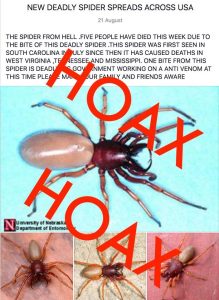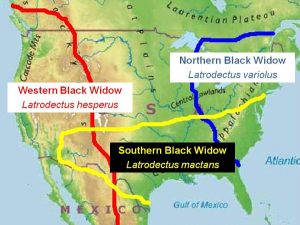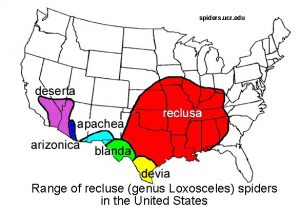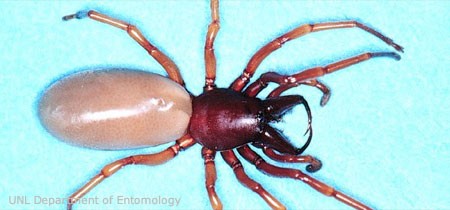BREAKING NEWS: NO NEW DEADLY SPIDERS IN USA
If you’re on Facebook, you may have noticed a new viral post that was created the day before yesterday (Aug. 21) warning people of a new spider that allegedly killed five people in the past week. The spider pictured on the post is a woodlouse spider, Dysdera crocata. It is native to the Mediterranean region, but was accidentally introduced to the United States and has since spread throughout the eastern and central United States, parts of the Pacific coast, and southeastern and southwestern Canada. Woodlouse spiders generally hide under stones or logs or in other dark, humid, enclosed spaces on or near the ground. They do not spin prey-capture webs, and instead actively hunt for their favorite prey – isopods (variously called woodlice, sowbugs, rolly pollies, potato bugs, and a huge list of other names… this is where scientific names are handy). These habitat preferences and active hunting lifestyle make them fairly common incidental invaders of homes, where they are most likely to be found in garages, basements, crawlspaces, or other dark, humid areas. A youtuber documented his experiences trying to coax one of these spiders to bite, and eventually succeeding, and reported that these spiders are not at all dangerous. To quote a study on bites by this spider from spider experts Vetter and Isbister (2006):
The spider pictured on the post is a woodlouse spider, Dysdera crocata. It is native to the Mediterranean region, but was accidentally introduced to the United States and has since spread throughout the eastern and central United States, parts of the Pacific coast, and southeastern and southwestern Canada. Woodlouse spiders generally hide under stones or logs or in other dark, humid, enclosed spaces on or near the ground. They do not spin prey-capture webs, and instead actively hunt for their favorite prey – isopods (variously called woodlice, sowbugs, rolly pollies, potato bugs, and a huge list of other names… this is where scientific names are handy). These habitat preferences and active hunting lifestyle make them fairly common incidental invaders of homes, where they are most likely to be found in garages, basements, crawlspaces, or other dark, humid areas. A youtuber documented his experiences trying to coax one of these spiders to bite, and eventually succeeding, and reported that these spiders are not at all dangerous. To quote a study on bites by this spider from spider experts Vetter and Isbister (2006):
Bites by the woodlouse spider, Dysdera crocata, are virtually innocuous. The main symptom is minor pain, typically lasting less than 1 h, probably due mostly to mechanical puncture of the skin. However, because the spider has a strong proclivity to bite, has large fangs which it bares when threatened and is commonly mistaken for the medically important brown recluse spider in the United States, documentation of the mild effects of its bites may prevent excessive, unwarranted and possibly harmful treatment.
Based on the real lack-of-threat posed by woodlice spiders, it would be reasonable to deduce that either the viral post is #fakenews or that woodlice have gotten organized and learned to use social media against their predato rs. However, the US is currently home to two types of medically significant spiders: widows (Latrodectus spp.) and recluses (Loxosceles spp.). Widows produce neurotoxic venom that makes their bites acutely painful, whereas recluses produce necrotic venom that can produce lesions that are slow to heal. Widows are almost always seen hanging upside-down in their remarkably strong cobwebs, whereas recluses tend to behave like extra shy and timid woodlouse spiders. Neither widows nor recluses are evenly distributed throughout the United States. The various widow species collectively have a broader distribution, but are very patchy, with greatest abundances in the southeastern and southwestern parts of the country. The recluses are found in the south-central US, ranging as far north as southern Illinois and Iowa. Myths around spiders abound, and recluses are the victims of an undeservedly bad reputation, so I’d highly recommend checking out Dr. Rick Vetter’s science-based website about them here. For more info on keeping spiders and their prey from colonizing your home, check out our other blog posts here and here.
rs. However, the US is currently home to two types of medically significant spiders: widows (Latrodectus spp.) and recluses (Loxosceles spp.). Widows produce neurotoxic venom that makes their bites acutely painful, whereas recluses produce necrotic venom that can produce lesions that are slow to heal. Widows are almost always seen hanging upside-down in their remarkably strong cobwebs, whereas recluses tend to behave like extra shy and timid woodlouse spiders. Neither widows nor recluses are evenly distributed throughout the United States. The various widow species collectively have a broader distribution, but are very patchy, with greatest abundances in the southeastern and southwestern parts of the country. The recluses are found in the south-central US, ranging as far north as southern Illinois and Iowa. Myths around spiders abound, and recluses are the victims of an undeservedly bad reputation, so I’d highly recommend checking out Dr. Rick Vetter’s science-based website about them here. For more info on keeping spiders and their prey from colonizing your home, check out our other blog posts here and here.


References:
Vetter, R. S. and Isbister, G. K. 2006. Verified bites by the woodlouse spider, Dysdera crocata. Toxicon 47(7): 826-829.






